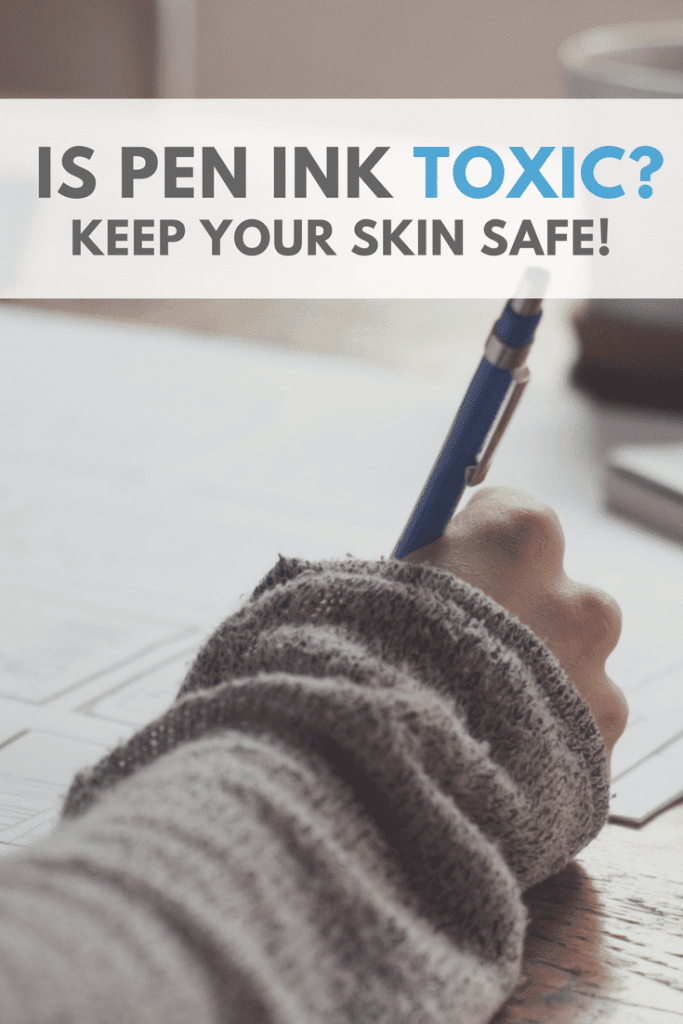I’m sure at some point in your life, especially as a kid and teen, you’ve used pens to draw on your own skin. Later as adults, it can still happen, when we need to write a quick note and there’s nothing around but a pen and our own hand. I sure have done this!
But is pen ink actually toxic, and can you get ink poisoning from a pen?
In general, ink pen is not bad for your skin. But if you tend to use a lot of inking pens, accidents might happen and it’s best to be careful. With that said, you’d need to be exposed to a very large quantity of pen ink for it to be considered dangerous.
But let’s explore this matter a bit more.

Table Of Contents
Different Toxicity Levels Of Ink
Nowadays, it’s really rare for people to get ink poisoning.
The reason for this is that the most common pens, like a ballpoint pen or bic pen, are made with non-toxic ink, and their manufacture is regulated in most countries. Of course, it should still be used carefully.
For example, if you have the habit of drawing on your own skin, do be careful not to do it near cuts or any open wounds you might have.
Even though the ink is non-toxic, you’ll still want to avoid any infections!

Now let’s see what you should be worried about.
Inks with dyes, alcohol, and other chemicals are something you should be more worried about, and they’re usually present in permanent markers, gel pens, highlighters, brush pens, etc.
But to be fair, the amount of these in one pen is so small that it’s very hard for you to get extreme ink poisoning.
What this means is that in most cases these aren’t particularly toxic chemicals.
The worst thing that could happen is getting quite a stain on your skin, lips or mouth and some minor symptoms that I will approach next!
Symptoms of Ink Poisoning
Ink pens like those in a permanent marker and brushes tend to spill, a lot!
These materials give up at some point and will try to ruin your work or your fingers… or your mouth if you have the habit of chewing on pens. Which might cause you to swallow some ink.
As I said, this has a minimal toxic level, but it can have some uncomfortable symptoms.
Stained Skin
With different kinds of pens, you might get your skin stained for longer periods of time. The ink can be hard to wash off but it shouldn’t be a problem in terms of toxicity.
Upset Stomach
In the case of digestion of ink, you might get an upset stomach and feel nauseous.

Skin Irritation And Eye Irritation From Ink
In general, ink poisoning won’t happen by simply drawing on your skin. It will stain your skin but won’t harm or poison it.
Some skin and eye irritation might happen in other cases, but it’s pretty rare.
Remember to wash your skin and eyes abundantly so the area is cleansed of ink.
If you’re still worried about using ink pens because of this, you can always try your hand at using a Digital Drawing Tablet.
I’ve recently written about how getting a tablet was one of my best decisions and it comes with the added bonus of being less messy!
In case of ink ingestion but there are no symptoms, drink some sips of water and wait, you should be fine though!
If there are symptoms for longer periods of time do try and get medical help as soon as possible.
Once again getting any symptoms is very rare, since you’d have to ingest a lot of ink and by a lot I mean, you’d have to ingest ink from like a dozen pens.
Now for the staining, this won’t cause you any trouble, but using any kind of harsh cleaning product won’t do very well for your skin, so try to avoid that!
You can try to wash it with some soap and water but it won’t do much. Just leave it be and it should disappear after a few days.
Skin irritation isn’t very common unless you have a pretty sensitive skin. With that said, it should just be an annoyance and not particularly negative to your health.
Different Types Of Pen Ink
Now let’s talk about the different types of pen ink.
Dip pens use water-based ink that tends to fade over time.
Ballpoint pens use oil-based ink mixed with pigments and dyes.
Fountain pens also use water-based ink mixed with dyes and surfactants for easy flow.
Rollerball ink pens are water-based and produce finer lines compared to ballpoint pens.
Gel ink pens have a thicker consistency but tend to smudge easily.
Each type of pen ink has its own unique properties and uses.

Dip Pens
If you frequently use dip pens, you should be aware of the different types of pen ink available and their effects on your skin.
Dip pens typically use water-based ink, which is generally safe and less toxic than other types of ink.
However, some individuals may still experience skin reactions or sensitivity to certain ink ingredients.
It’s important to practice proper safety measures, avoid ingestion of ink, and seek medical advice if any adverse reactions occur.
Ballpoint Pens
When it comes to ballpoint pens, there are various types of pen ink that you should know about.
See the table below for a breakdown of the different types of ballpoint pen inks and their potential effects on the skin:
| Type of Pen Ink | Composition | Potential Effects on Skin |
|---|---|---|
| Oil-based ink | Oil + pigments and dyes | Can be harmful and cause skin irritation |
| Water-based ink | Water + pigments and dyes | Generally safe, minimal risk of skin irritation |
In general, you’ll be fine using ballpoint pens though, especially if you just accidentally spilled small doses!
Fountain Pens
Fountain pens use water-based ink, which is mixed with dyes and surfactants for smooth flow.
Unlike permanent ink, fountain pen ink can be easily washed off the skin.
However, it’s still possible for fountain pen ink to stain the skin temporarily.
To prevent staining, it’s recommended to clean the skin promptly after using fountain pens.
Rollerball Ink Pens
When using rollerball ink pens, you may encounter another type of pen ink that offers finer lines compared to ballpoint pens.
Rollerball ink pens use water-based ink that contains dyes for color.
This type of ink is easily absorbed by the skin and can stain it.
If you have sensitive skin or are prone to allergies, be cautious when using rollerball ink pens.
If you experience symptoms such as skin irritation or allergic reactions, seek medical advice immediately.
Gel Ink Pens
Gel ink pens offer a thicker consistency compared to other types of pen ink.
They’re commonly used for drawing and writing. While gel ink pens may provide vibrant colors and smooth writing, there are risks associated with using them on the skin.
Gel ink can easily smudge and may cause skin irritation or allergic reactions.
It’s important to clean the skin properly after using gel ink pens to minimize the risk of infection.
Sharpie Markers
Sharpie markers are known for their long-lasting ink and are generally safe to use on the skin.
They don’t contain toxic ingredients that can cause poisoning.
However, they can potentially irritate the skin. It’s recommended to avoid using Sharpie markers on sensitive or broken skin.
For drawing or writing on the skin, it’s best to use non-toxic pens or markers specifically made for skin application.
Components Of Pen Ink
The components of pen ink include:
- Pigments
- Dyes
- Solvents
- Resins
- Surfactants
- Lubricants
These components determine the color, consistency, and other properties of the ink.
Pigments and dyes provide the color, with pigments being insoluble in water and dyes being soluble.
Solvents act as the liquid base of the ink, while resins serve as binding agents.
Surfactants and lubricants are added to enhance the ink’s flow and performance.
Is Pen Ink Toxic for Tattoos
Just… don’t do it! This isn’t just a matter of the pen ink, it’s mostly the DIY factor.
Like we just talked about, writing ink is not toxic… in small doses!
But when tattooing, you’re basically injecting ink on yourself.
There’s a reason why tattoo inks exist.
They’re made to have as few chemicals and allergens as possible and in very sterile environments.
You can even very easily get tattoo ink on Amazon, but honestly? If you’re inexperienced and don’t even own a machine yet, don’t try it.

Using ink for DIY tattoos is very dangerous. You can get serious infections.
It’s not by accident that making a tattoo tends to be expensive, not only you’re paying an artist to make art for and on you. This person is a professional, who learned the process and who already has quite the experience.
The aftercare of your tattoo is also very important, so please be careful.
That’s how I got my first tattoo, done by a professional!
I didn’t know what I wanted yet, nor did I have the money for it. But I was following some artists and my favorite happened to make a flash day, and now I have this rad Boba Fett tattoo!

Remember that the most important thing to consider is how clean and sterile the place is.
Usually, tattoo parlors need to follow rules, like opening everything in front of you, so you know that the materials are sterile and new.
And once again, please do not try to go the DIY route, with weird materials, you can be lucky sure, but you can also end up with an infection, gangrene to be more specific, so if you don’t want any of that happening, be safe!
Is a Bic Pen Toxic?
The package of each pen itself usually tells you it’s non-toxic.
So you’re safe. BIC Pens aren’t toxic.
A Bic pen is a regular ballpoint pen, so if you’ve read everything above, you already know you’re good! Personally, I like to use Bic pens the most, I really like their feeling and there’s a lot of colors to choose from.
So if you want to draw with some ballpoint pens, I do recommend these ones.

Also, from experience, I never had problems with extra ink spilling from my pen. From all the Bic pens I’ve bought, it has probably happened once or twice. Another advantage is that they’re quite cheap and can come in big packages if you wish to get a lot of them at once and save them for whenever you need them!
Pen Ink and Small Children
If you’re a parent, chances are you’re always worried about anything that can harm your kids.
And this includes the toxicity of pen ink.
But let me say right out of the gate: Pen ink is non-toxic, even if swallowed or gone through the skin or eye.
The general possibility of getting poisoned by ink is very slim, so don’t worry about this.
I know worrying is fairly normal.
And as someone who has two younger siblings, with a big age gap and had to babysit them a lot, I know how worrying it is and how they can always find something that will harm them.

We also know that children like to scribble drawings in each other’s arms at school, I’ve been there as well! Like we’ve been through, this isn’t really problematic.
Ballpoints are safe for children to use and even if some ingestion occurs, just keep an eye on them, give them some water to sip and wait out a bit.
Even if your child had some ink swallowed, in most cases it shouldn’t be a problem.
Of course, you might still be reluctant and if so, just check the packages when buying pens.
Try to look for the ones that say non-toxic or for something that has no alcohol or other chemicals, and you should be safe.
Swallowing ink happens, so if you or your child feels their stomach upset for a longer period of time, you should check a doctor.
Ink Stains? Removing Pen Ink from Fabric
Ok, so the first thing you should check is the type of ink you just spilled on your shirt. Is it water-based? Oil-based? Or is it permanent? Ballpoint pens usually have oil-based inks, which can be a bit more complicated to clean fabric, but doable.
The easier to clean is, of course, water-based inks, such as most felt tip pens.
The second thing to check is your shirt. If it’s machine-washable, you can safely clean it yourself.
But if it’s a fabric that needs to be washed by hand or dry cleaning, maybe it’s better to bring it to a dry-cleaner. Just be sure to tell them what kind of pen did the staining, so they know how to deal with it.

Now, how to clean the stain:
- For water-based ink stains: get a cotton ball, put some alcohol in it, the type you usually have at home to disinfect wounds, and rub it firmly on the stain until it’s absorbed into the cotton ball. Water-based ink stains are usually found in fountain pens for example. The stain should leave the fabric very easily. Funny enough, milk is also a popular method. Just drop some milk in the stained area and wait for about half an hour. Then scrub the stain gently with a toothbrush and rinse it with warm water.
- For oil-based ink stains: most commonly found in ballpoint pens. This one is harder to clean. But you can also use some alcohol to clean it. Let it sit for about 5 minutes. Use a clean, dry cloth to clean the stain. It should come off fairly easily. If there’s still some ink left, repeat the process.
- For permanent ink stains: this one is about how fast you take care of it. If you notice the stain right away, use the methods above immediately! If needed, repeat the process more than once. Lemon juice, acetone, and hairspray are also commonly used to clean permanent markers. Just remember that you might still have some residue left after a few tries, but a good cleaning might soften the blow until it’s hardly noticeable.
On another note, don’t forget to always put a towel or some paper towels beneath the stain, so the rest of your fabric stays safe.
Frequently Asked Questions
Let’s go over some questions related to using pen ink on the skin and the harm it can possibly have!
What Is Pen Ink?
Pen ink is a substance used for drawing, writing, or printing. It can contain various chemicals that may have effects on the skin.
Ink poisoning is rare, as the toxicity level is low.
However, ink can cause skin irritation or allergies.
It’s important to properly clean and care for the skin to minimize risks. If skin problems occur, seeking medical advice is recommended.
Is Pen Ink Bad for Your Skin?
In general, pen ink isn’t bad for your skin, including markers and Bic pens. While short-term use presents no harm, prolonged or excessive application may lead to skin irritations, allergies, and other potential long-term issues.
So, using caution and moderation when applying ink to your skin is advisable for a safer experience.
Pen ink from fountain pens, ballpoint, and felt tip pens are very rarely toxic, and unless you ingest a lot of it, you should be fine.
But in general, I don’t recommend you to use pen ink on your skin.
How Long Does It Take For Ink To Fade From Your Skin?
When writing on your skin with pen ink, you may wonder how long it takes for the ink to fade.
The duration of ink fading can vary depending on several factors such as the type of pen ink used, the composition of the ink, and individual skin characteristics.
Generally, pen ink on the skin can last for a few days to a few weeks.
However, if you use a semi-permanent tattoo pen or marker, the writing may last longer, up to several months.
If some symptoms of pen ink poisoning do appear, look for medical help immediately.
So do try to be always careful and have fun with your inks (on paper!)
And if you’re looking for suggestions on what pens to use, here are the 12 Best Drawing Pens For Artists In 2023 (Cheap And Budget Friendly!).

Patricia Caldeira is the main writer here at Don Corgi. She's an art teacher with over 20.000 happy students across many platforms and courses!
Enjoy your stay and as always:
Keep on drawing!



